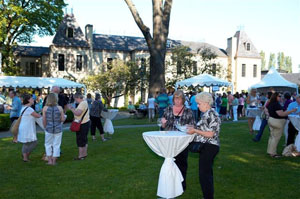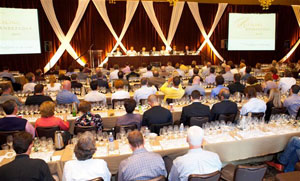The third Riesling Rendezvous hosted jointly by Ernie Loosen, and Château Ste. Michelle ended last week in Seattle with over 350 wine professionals attending from all corners of the world getting a fascinating glimpse into Riesling’s past, present and future. Joel B Payne who was present at the conference reports.
 |
| Riesling Rendezvous Grand Tasting at Chateau Ste. Michelle July 11. |
“Although Riesling is only the world's 20th most widely planted grape, it must be included among the top three white varietals because of it innate ability to express the unique character of its place of origin,“ said Ted Baseler, President of Château Ste. Michelle in his opening remarks, thus setting the stage for the three-day conference.
Numerous workshops investigating this trait, as well as Riesling’s capacity to age, highlighted over a dozen Old World luminaries such as Etienne Hugel from Alsace, Helmut Dönnhoff from the Nahe and Fred Loimer from Kamptal. On the other hand, Tom Barry from the Clare Valley, John Forrest from Marlborough and Peter Bell from Fox Run in New York were among the well-known personalities that provided the New World its voice.
 |
| Riesling Rendezvous International Off-Dry Riesling Tasting July 12 |
Stuart Pigott, who acted as an informal master of ceremonies throughout, evoked Riesling’s storied past. Not only were dry German Rieslings once the most expensive wines in the world, but even a Chinese Riesling was awarded ‘wine of show’ at the 1915 exhibition in San Francisco, according to him.
Jim Trezise, Chairman of the International Riesling Foundation (IRF), confirmed in his presentation that “Riesling is now the fastest growing varietal in American sales.” Granted from a small base, observed John Gillespie, a partner at Wine Colleagues, adding that “although an equal number of consumers now rate Riesling among their preferred wines, they drink them less often than Chardonnay and are confused by the variations in sweetness.”
This is why the IRF has introduced a Riesling Taste Profile for the back label that gives the consumer an idea of each individual wine’s flavour. Now used on some 15 million bottles of its member’s wines, the foundation hopes that it will make buying a bottle of Riesling less daunting for the uninitiated.
Among the many tastings, the most interesting was led by Bruce Schoenfeld, the wine editor from Travel & Leisure, which with almost five million copies sold is the world’s leading travel magazine. After each of the fourteen stellar wines presented blind, he persistently asked why we intuitively know what is New World and what is Old? Although no easy answers to his question were found, the richness felt on the palate of the Old World style due to extended hang time and those producer’s willingness to embrace the added complexity of phenolic extract, often an anathema to their colleagues in the New World, were generally perceived as the lode stars.
While global warming has been kind to cool climate fruit, Dr. Greg Jones from Southern Oregon University and Professor Hans Schultz from Geisenhim presented new data on how rising temperatures might affect Riesling’s future, shifting not only optimum production sites further north, to higher altitudes and cooler sites, but also demanding that viticulturalists look to different forms of canopy management to guarantee fruit balance.
Almost sixty years ago, Maynard Amerine and Albert Winkler from the University of California at Davis had classified zones with average temperatures between 13.2 and 15.2° Celsius during the ripening period from the 1st of April and the 31st of October as the optimum sites for Riesling. Since then temperatures in classical growing regions such as Rheingau, Wachau and Alsace have risen by just over 1°, engendering a welcome consistency in quality there and fuelling a rise in production in hitherto unknown areas such as the Finger Lakes in New York, the Niagara Falls in Ontario or the Old Mission Peninsula in Michigan.
“As clonal material, rootstock and vineyard management continue to improve, it is unclear that the upper boundary of 15.2° is set in stone,” concluded Dr. Jones, “but if temperatures rise by another 1.5 to as much as 5° over the coming years, as we expect, and rainfall patterns change, warmer regions with lots of sunshine hours like the Clare or Eden Valleys in Australia will have to adapt.”
Already 2010 is predicted to be the hottest year on record.
The next Riesling Rendezvous at Ste. Michelle will be held in 2013. In the meantime, the now associated International Riesling Symposium will take place in the Rheingau at Schloss Reinhartshausen in November 2010 and then under the guidance of Australia’s Frankland Estate in Melbourne in February 2012.
Riesling lovers should mark those dates.
Joel B Payne
 Joel B. Payne, an American expat living in Europe since 1979 was thrice Germany's best sommelier. Beyond a long career as wine buyer, consultant and managing director of two large import companies, he has been active as a wine journalist for 25 years.. A regular contributor to several leading international and German wine magazines , he is best known for being the editor of the German Wine Guide, which has appeared annually for the past 17 years. A founding member of the Grand Jury Européen, he is also since 2007 the president of the international circle of wine writers, FIJEV. Joel B. Payne, an American expat living in Europe since 1979 was thrice Germany's best sommelier. Beyond a long career as wine buyer, consultant and managing director of two large import companies, he has been active as a wine journalist for 25 years.. A regular contributor to several leading international and German wine magazines , he is best known for being the editor of the German Wine Guide, which has appeared annually for the past 17 years. A founding member of the Grand Jury Européen, he is also since 2007 the president of the international circle of wine writers, FIJEV.
|